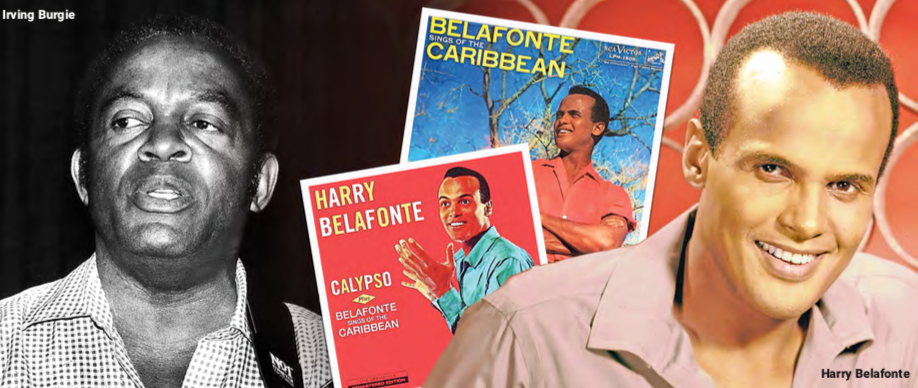“A Heartfelt ‘Jamaica Farewell’ to One of America’s Most Beloved Singers and Civil Rights Activists”
With the passing of Harry Belafonte at 96 years old, America has lost one of its most unique and important voices in the civil rights movement. He was one of the biggest recording stars of the 1950s and ’60s, broke down color barriers as an entertainer and marched alongside Dr. King in Montgomery, Alabama. Additionally, Harry Belafonte helped popularize his beloved Calypso music for the world to hear and enjoy.
The popularity of Caribbean music on the American music charts can be credited, in large part, to singer, songwriter, actor, and civil rights activist Harry Belafonte’s landmark recordings. While Belafonte did not invent the breezy folk-influenced style of calypso music, he did record songs that helped define it for a legion of fans during the late 1950s, when he teamed up with singer-songwriter Irving Burgie, then professionally known as Lord Burgess.
Harold George Belafonte was born on March 1, 1927, in Harlem. His mother was a devout Catholic from Jamaica, and his father hailed from Martinique. When Belafonte was eight years old, his family moved to the Caribbean where he spent five years living near Kingston, Jamaica, before returning to New York City and pursuing a music career, ultimately performing folk songs in Greenwich Village nightclubs.
Belafonte recorded 12 charting singles between 1952 and 1957. He also recorded dozens of best-selling albums over 30 years and won three Grammy Awards, an Emmy Award, and a Tony Award. In 1989, he received the prestigious Kennedy Center Honors. He was also at the forefront of the civil rights movement during the 1950s and 1960s; he walked alongside his friend, Dr. Martin Luther King, Jr., during the 1965 civil rights march from Selma to Montgomery, Alabama.
Belafonte first made the Top 40 on the Billboard pop chart in 1952 with his recording of the poignant folk-country ballad, “Scarlet Ribbons (For Her Hair),” which had previously been released by singer Jo Stafford, and later became a hit for The Browns in 1959. Belafonte released his first album, “Mark Twain and Other Folk Favorites,” in 1956. It made it to No. 3 on the album chart, and his second album, simply titled “Belafonte,” reached No. 1.
But it wasn’t until later that same year that his music career took off with the release of the album “Calypso,” which remained at the top of the chart for an astounding 31 weeks and became the first million-selling album by a single artist.
One of the things that made Calypso so special was the selection of songs, eight of which were written by Burgie, who was born in Brooklyn in 1924 and died in the borough in 2019. Burgie’s mother was from Barbados, and he loved to sing the songs of his maternal homeland. Burgie met Belafonte in 1950 while Burgie was performing in New York City folk clubs as Lord Burgess. He started writing his own songs about the islands and revising the tunes he had learned as a child. Burgie would ultimately compose 34 songs for Belafonte.
The Calypso album opened with the now-classic “Day-O (The Banana Boat Song),” a traditional Jamaican folk song arranged by William Attaway, an African-American novelist and songwriter, as well as Belafonte and Burgie. Its opening chant of “Daylight come and me wanna go home,” expresses the plaintive cry of banana crop harvesters waiting late at night and into the next day for their wares to be counted and loaded onto ships so that they could go home.
Belafonte imbues the song with a sense of urgency, telling of the workers’ boasts of having collected “six-foot, seven-foot, eight-foot” bunches of ripe bananas for loading onto the boats. The song reached No. 5 on the pop chart and has since become Belafonte’s signature song.
The album also included Burgie’s lovely “I Do Adore Her,” wherein the singer wishes to let his love know how much she meant to him, and Burgie’s adaptation of the West Indian folk song “Jamaica Farewell.” This was in fact the first single from the album, reaching No. 14 in 1956. The song is a standout as the singer recalls the beauty of the West Indian island he is leaving behind. He explains in the opening line how he is mesmerized by Jamaica, “where the nights are gay and the sun shines daily on the mountaintop.” Sadly, he explains that he has to go and “won’t be back for many a day,” as he pines for the girl he has to leave behind in Kingston Town. The descriptive ballad remains one of Belafonte’s most beloved performances and has since been recorded by dozens of artists.
Burgie also contributed the light-hearted “Dolly Dawn” and collaborated with Belafonte and Attaway on “Star-O,” a song that incorporates a similar theme and melody to “Day-O.” It even includes essentially the same chorus of “Come, Mr. Tally Man, tally me banana; Star a come and I carry me load,” in place of “Daylight come and me wanna go home.”
Belafonte’s follow-up single to “Day-O,” was a reissue of “Hold ‘Em Joe,” a Broadway show tune with which he originally had made the Top-40 in 1954. This time around it did not fare as well, but he then returned to the Calypso sound with “Mama Look a Boo Boo,” a traditional island song adapted by Burgie, Belafonte, and Trinidadian artist Lord Melody. The lyric tells of a father who thinks people don’t like him because he’s ugly. Even his children mock him, explaining, “Mama look a boo-boo, they shout, their mother tell them, ‘shut up your mouth, that is your daddy,’ Oh, no, my daddy can’t be ugly so.”
Following up on the success of Calypso, he released the album “Belafonte Sings of the Caribbean” in 1957. Burgie had a hand in writing 10 of the 11 songs on the LP, with Burgie and Belafonte collaborating on six tracks. Two of those songs became hits for Belafonte that same year.
“Coconut Woman” is a catchy tune about a woman who sells coconuts by promoting their benefits for cooking, making candy, and “the thing that’s best if you’re feelin’ glum is coconut water with a little rum.” It’s a fun song that reached No. 25 on the pop chart. In contrast, the Top 30 follow-up “Island in the Sun” is a stunning ballad about the beauty of the island from which the singer hails, with “your forest waters and your shining sun.” Its hauntingly beautiful imagery reflects his love for his homeland. It also served as the title song for the 1957 hit movie starring Belafonte.
One of Belafonte’s most enduring songs is the Calypso-influenced “Mary’s Boy Child,” a dramatic retelling of the story of Christ. The opening lines poetically set the tone for the religious ballad: “A long time ago in Bethlehem, so the Holy Bible say, Mary’s boy child, Jesus Christ, was born on Christmas Day.” The song was written by actor and songwriter Jester Hairston, who appeared on “The Amos ‘n’ Andy Show.” “Mary’s Boy Child” has become a seasonal standard. It reached No. 12 in 1956; while other artists have performed it, Belafonte has always owned it.
In 1961 Belafonte released “Jump Up Calypso,” another successful collection of West Indian music that reached No. 3 on the album chart. While Belafonte and Burgie did not collaborate on any of the songs, the album featured six songs by Burgie. Highlights included Burgie’s “Land of Sea and Sun,” a nostalgic look back upon the girl the singer left behind; he is determined to “go back there to see her before my days are done; going back to see her in the land of the sea and sun.”
Burgie’s “Angelina” is a rousing Calypso tune about the singer beckoning his girl to bring down her concertina and welcome him home from the sea. We’re told that he has “sailed around the Horn; I’ve been from San Jose up to Baffin Bay and I’ve rode out many a storm.”
Five years later, Belafonte released the album “Calypso in Brass,” featuring 11 songs from his catalog with new arrangements accompanied by a full orchestra with horns. Among the highlights was a unique take on “Coconut Woman.” Belafonte ushered in the 1970s with his fifth and final Calypso album, “Calypso Carnival.” It was his first Calypso album not to make the pop album chart.
Burgie died in 2019 at his home in Queens, leaving behind a catalog of timeless songs and a number of recordings as Lord Burgess. His contribution to West Indian music cannot be overstated. He was inducted into the prestigious Songwriters Hall of Fame in 2007, and he told his own remarkable story in “Day O!!! The Autobiography of Irving Burgie.”
Belafonte played a major role in United Support of Artists for Africa (USA for Africa) in the mid-1980s and was a leading voice in fighting apartheid in South Africa. He served as a UNICEF Goodwill Ambassador and was awarded the National Medal of Arts in 1994. He received the Grammy Lifetime Achievement Award in 2000 for his unsurpassed body of work.
Belafonte’s life was a study in cultural innovation and humanitarianism. His songs will be sung for generations to come and his good works and deeds will live on forever. Chances are that somewhere along the path of the next West Indian Day parade you will hear the familiar refrain of “Day-O.” It is all thanks to a music icon who found the perfect way to celebrate his Jamaican heritage, share it with the world, and ultimately have the world sing along with him.
This story has been updated and was previously published in September 2021.


